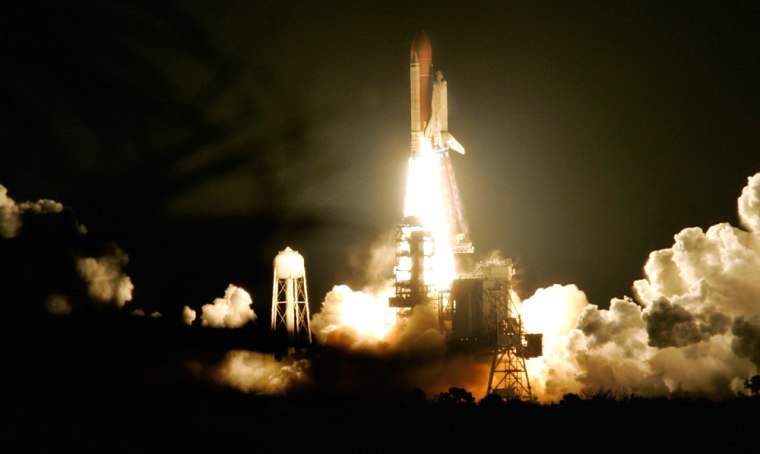Discovery lit up the sky late Saturday, blazing off for the first nighttime space shuttle launch in four years — the latest step in NASA’s ambitious schedule to complete the international space station.
The shuttle’s fiery ascent turned night into day for spectators at the Kennedy Space Center. A cloudy sky with blustery winds earlier in the day gave way to clear skies and a gentle breeze at launch time.
“I think we have five people who just haven’t stopped smiling yet,” commander Mark Polansky said after Discovery reached space.
The mission is one leg of a three-year race to finish construction on the orbiting outpost before shuttles are retired in 2010. After Discovery’s mission, 13 more shuttle flights are needed to complete the space lab.
Low clouds forced the space agency to scrub a launch attempt Thursday night during a countdown that ran down to the wire. Managers decided not to try again Friday because the forecast looked even worse.
“Forty-eight hours makes a tremendous difference,” launch director Mike Leinbach told the crew.
At the beginning of the day, delays in getting Discovery's external tank ready for fueling put NASA as much as two hours behind its time line, but the launch team made up the time as the countdown proceeded. "Everything just clicked," Leinbach told reporters after launch. “Everything felt good today.”
Rewiring the space station
During their 12-day mission, Discovery’s crew will rewire the space station, deliver an $11 million addition to the space lab and bring home one of the space station’s three crew members, German astronaut Thomas Reiter of the European Space Agency. American astronaut Sunita “Suni” Williams will replace him, staying for six months.
The launch was the first at night since Endeavour’s flight in November 2002 and only the 29th in darkness, out of NASA’s 117 total shuttle launches.
“What you’ve seen tonight is the successful accomplishment of the most challenging, demanding, technically state of the art, difficult thing that this nation or any nation can do,” NASA Administrator Michael Griffin said.
Mission Control told Discovery’s crew that there were no initial reports of any serious problems and that the shuttle was “in great shape.”
“If this is any indication, it’s a great start to a great mission,” Polansky radioed back.
Engineers still need to review imagery and radar to look for damage to the shuttle from debris falling off the external tank during liftoff, the problem that doomed Columbia.
NASA had required daylight launches for three flights after the Columbia accident in 2003 so that clear images could be taken of the external fuel tank. Foam broke off Columbia’s tank at liftoff and struck the spacecraft’s wing, leading to the disaster that killed seven astronauts.
Waiting at the space station for his visitors to arrive on Monday, U.S. astronaut Michael Lopez-Alegria told Mission Control, “We’re going to head out and turn our porch light on so they can find us.”
Referring to Williams’ first flight, Lopez-Alegria told the shuttle crew: “I hope Suni likes it. She’s going to be there for a while.”
Greenest crew in years
Discovery’s crew is the greenest in eight years when it comes to spaceflight experience. Five astronauts have never flown in a shuttle before. The last time a shuttle mission had five rookies was a Columbia crew that flew in April 1998.
Slideshow 12 photos
Month in Space: January 2014
The two veterans are Discovery commander Polansky and mission specialist Robert Curbeam. The others are pilot William Oefelein, and mission specialists Joan Higginbotham, Nicholas Patrick, Williams and the European Space Agency’s Christer Fuglesang, who was the first Swede in space.
It also is among the most culturally diverse of any shuttle crew.
Besides the Swede, there are two black astronauts (Curbeam and Higginbotham), an astronaut of Indian descent (Williams), a British-born mission specialist (Patrick), an Alaskan (Oefelein) and a New Jersey boy (Polansky).
Three of Discovery’s astronauts will take three complicated spacewalks and play the role of electricians by rewiring the space station from a temporary to a permanent power source. Curbeam will pair up with Fuglesang for the first two outings, and with Williams for the last one.
Back by Christmas
NASA officials were glad to get the shuttle off their ground since they wanted it back on Earth by the new year.
Shuttle computers are not designed to make the change from the 365th day of the old year to the first day of the new year while in flight. The space agency has figured out a solution for the New Year’s Day problem, but managers are reluctant to try it.
With Saturday's launch, Discovery is set to land back at Kennedy Space Center on Dec. 21, with an option for extending the mission by a couple of days if need be.
This was the third shuttle launch of the year, and only the fourth since the Columbia disaster in 2003.
This report was supplemented by information from MSNBC.com's Alan Boyle.

